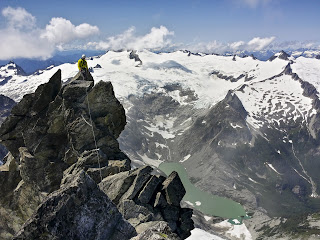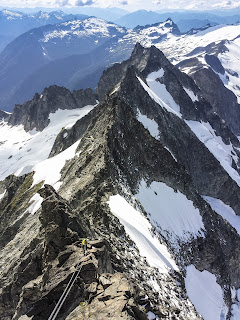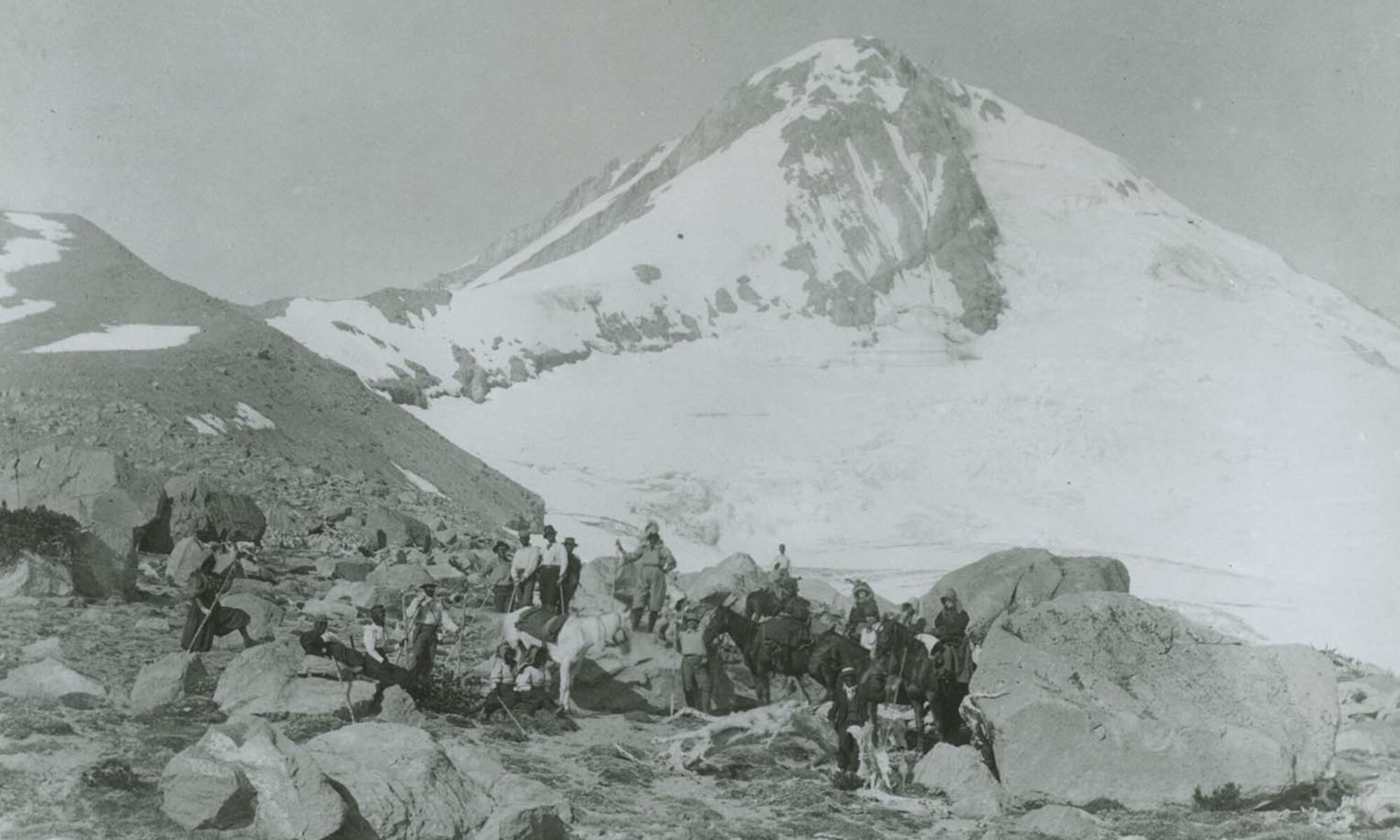 |
|
Steve Marston on Forbidden Peak. Photo: Al Papesh.
|
by Barry Maletzky
Most of us know about the snow-clad, rugged giants north of Mt. Rainier. Yet, due to distance and a five-day work week for many Mazamas, these giants only rarely appear on the Climbing Schedule. In my opinion these areas, such as the Glacier Peak Wilderness, the North Cascades National Park, and the Mt. Baker/Snoqualmie Wilderness, contain the most spectacular scenery in the lower 48. Blessed with almost too much winter moisture, glaciers abound, cradling gushing streams and waterfalls, feeding the rich volcanic soil, and nurturing gardens of wildflowers seemingly seeded in heaven. These descriptions are written not as definitive guides to access and routes, but to encourage the outdoor enthusiast to seek out these areas off the main tracks we Mazamas so often trod and discover their jeweled treasures.
Sloan Peak (7,835 ft.)
Among these “hidden” gems, Sloan may shine the brightest in terms of Mazama popularity. Ruling in majestic isolation at the western end of the Glacier Peak Wilderness, Sloan’s Matterhorn-like, convoluted appearance belies its relatively benign nature as a climb, at least by its regular route. Sloan’s distinctive horn can be easily identified from most other peaks in the western Cascades, from Rainier all the way to the Canadian border. You may have to get your feet wet crossing a branch of the Sauk River, so autumn is the preferred season for Sloan. A steep approach trail is rewarded by campsites in a secret meadow guarded by rugged towers of stone. The gradual ascent of the Sloan Glacier leads the climber from east of the summit almost, but not quite, around the peak (hence the name of the route as “The Corkscrew”); a usually easy climb up the rocks at the highest western point of the glacier brings one to a surprisingly pleasant meadow stroll through alpine flora to the rocky summit (reached by Class 3 scrambling). Views are handsomely rewarded of the Monte Cristos to the southeast and Glacier Peak just across the river.
Fortress (8,760 ft.)
After a long ride on a dirt track, followed by a 9-mile path tempered by the beauty of magic meadows and surrounding peaks, one reaches Buck Creek Pass, surely one of the most glorious places to camp, especially to catch the fading sun setting over Glacier Peak. On climb day, head north on a climber’s track, then ascend the southwest gardens of Fortress, a secret place you’ll usually have to yourself. (Try to keep the meadow in as natural a state as you can—there are rare flowers hidden here.) Turn north at the ridge and scramble stable talus to the rocky top, where a few rare species of alpine floral jewels remain in bloom throughout the summer. The views encompass all of the Glacier Peak Wilderness as well as the North Cascades Peaks in all their glory.
Colonial/Snowfield Peaks (7,771/8,347 ft.)
 |
|
Climber on the summit of Mt. Larrabee, 1.5 miles south
of the Canadian border (“All-in-all, no finer view can be
obtained without a rope in all these ranges”)
Photo: Beau Ramsey.
|
These jewels, securing the western end of the National Park, occasionally appear on the Mazama Climb Schedule, and for good reason. Once past the trail to Pinnacle Lake, a climber’s path can be followed to a magnificent ridge that offers vistas north and south into snow-covered heights, including Snowking, the mysterious Illabot range, with its pointed pencil of a peak: Mt. Chaval, and grand views northwest to the Picket Range (and Baker and Shuksan). Most parties climb Colonial but an extra day ascending Snowfield broadens the views further and provides a chance to walk one of the most beautiful glaciers in the range, the Neve Glacier: broad, serene and embraced at both side moraines by flowery gardens interspersed with rugged ramparts of multi-colored rock. Both ascents feature glacier travel ending in brief Class 3 rock scrambles. One further benefit: a view into the Teebone and Backbone Ridges, with names to excite the adventurous, such as The Sacrum, The Coccyx, and Lumbar Point, all rarely seen from any easily-reached vantage point.
Forbidden (8,815 ft.)
Forbidden bears its name well; although not of towering height, abrupt angular landforms lead, more steeply as you ascend, to a summit tip sufficiently edged to make most climbers dread to tread. However, Forbidden has become an increasingly popular climb due to its east ridge, which goes at about 5.7, and its more frequently climbed west ridge, at about 5.5. It also has the benefits of being in one of the most gorgeous settings for a base camp: Boston Basin. Forbidden’s immense obelisk of rock provides chillingly grandiose views from either ridge, as well as from its summit. All the North Cascade peaks up to Baker are there for the taking, but to my eyes, the sawteeth of Ripsaw Ridge, with countless shards of rock jutting above the immense white sheet of the Boston Glacier and stretching all the way to Mt. Buckner, is one of the most overpowering and memorable sights in any range I have visited in the lower 48. Reaching this summit and making it back down again will provide you with more than hero cred; it will inspire dreams of towers and walls previously unimaginable. This is the closest one can come to Patagonia without leaving this country.
Boston Peak (8.894 ft.)
 |
|
Steve Marston descending the west ridge
of Forbidden Peak. Photo: Al Papesh.
|
Boston is a rarely attempted alternative to the crowded Mt. Sahale; the views are similar to those from Sahale but even more far-flung, ranging from Rainier to the south through the sharpened teeth of the Pickets, and most of the significant mountains in the National Park. Do not be alarmed by the view of Boston from Sahale; appearing from the south as a sharpened vertical shroud, the actual climb is graded at Class 3 with a few stretches of brief Class 4. Aficionados of shattered rock will appreciate the ascent up a well-defined line on the southeast face. A relatively large ridge trends eastward toward a series of chimney and face moves with stable holds all the way to the view-laden summit. While hard hats are a necessity, many parties fail to use a cord, fearful of falling rock. Much closer views of the North Cascade giants will be your reward: Eldorado, anchoring the range to the west, its northern ridge of castellated pinnacles terminating in the massifs of Snowfield and Colonial Peaks; and the steeply angled slopes of Terror and Despair; all backcountry views to be savored by the very few venturing beyond Sahale.
Ragged Ridge (7,408—8795 ft.)
An oft-neglected ridge paralleling the North Cascades Highway west to east, Ragged presents the largest unbroken series of rugged summits outside of the Pickets in the entire North Cascades. Beginning in the west with Red Mountain, an easy scramble from a campsite in Fourth of July Basin, the ridge continues with scrambling on flaky rock. The adventurous party could run the entire ridge in several days, traversing high points such as Cosho, Kimtah, and Katsuk Peaks (mostly scrambles at the Class 3 level). Near its east end, the tallest and best-known summit, Mesachie Peak (Class 4 in spots), pierces the Washington sky with fractured gullies and jagged pinnacles. Most of these peaks can be ascended in a single day from bug-infested camps along Fisher Creek. So why go? To stand on a pinnacle here and there that no other person on earth has ever shared? Yes, but I think it’s the views: seemingly world-wide and ever changing. Rarely would anyone have the opportunity to summit a peak and see the full extent of the National Park, from Goode, Logan and Silver Star in the east, to El Dorado in the west.
Silver Star (8,876 ft.)
Anyone travelling the North Cascades Highway can’t help but be impressed with the hulk of Silver Star, with its jagged tottering towers and gables of rock. This marvel of the eastern part of the National Park area, the highest point in the Methow Range, offers spectacular views of its west and north sides from the multiple loops of Highway 20. A relatively easy single-day ascent is feasible from the highway up the eastern gullies, traversing a glacier then scrambling Class 3 rock. Crampons and ice axe are advised: crossing over to the north face, the glacier can be crevassed after mid-summer and portions can be steep. Views of the Yosemite-like eastern faces of Liberty Bell, Early Winters Spires, and Kangaroo Ridge right next door make the trip from Portland more than worthwhile. In addition, the rarely seen Mts. Azurite and Ballard to the north, and the appropriately-named Needles, sharply incised Cutthroat and Mt. Wheeler, all to the northeast, impress from across the highway. Most parties take an extra day camping at Early Winters Campground and visit the ersatz cowboy town of Winthrop for well-earned beer, burgers and ice cream.
Crater Mountain (8,128 ft.)
Sometimes it feels good, especially for a weekend punter like me, to just meander up an easy peak from a superb campsite and take in the views without having to worry about making it down alive. (Climbers are the only folks I know who celebrate at half-time—you still have to descend!) Right next to the behemoth of Jack Mountain, but absent the drama of hidden crevasses, impenetrable Class 5.9 brush, and the multiple route choices of its fearsome neighbor to the north, Crater is approached by the well maintained McMillan Park-Jackita Ridge Trail to Crater Lake. A base camp on the ridge above the lake provides ample views of most of the North Cascades plus a vista of Jack (which makes you happy you aren’t attempting that convoluted giant the next day). A climber’s path leads across scree and flower-filled meadows until you are presented with a headwall. But not to fear, the way is marked by huge yellow dots painted on the rocks by an explorer anxious to not lose the way; the dots point out the easiest and most stable holds (Class 3 at most). You emerge again upon a sandy plain dotted with alpine flowers and proceed up the climber’s path to the summit. Views are unique: Azurite and Ballard to the east, while Jack dominates as never before, raising its steely heights above the Jerry Glacier. You can spot (and argue about) the many North Cascades summits visible, including Colonial and Snowfield to the west, the Dome group to the south, and the Needles to the east.
Icy Peak (7,073 ft.)
Who hasn’t climbed Ruth Mountain, northeast of Mt. Baker, and exclaimed, “This is the best view for the easiest climb I’ve ever done.” They may be wrong: the view from Ruth’s southern neighbor, Icy Peak, may be even more magnificent (although it cannot be climbed by the average mountaineer in a day and requires glacier gear). From the Hannegan Pass Trail, haul your pack up the climber’s track to some of the loftiest and most view-worthy campsites in all the North Cascades. You’ll probably have time to tarry a bit to enjoy the luscious blueberries (Vaccinium deliciosum—really!). On climb day you may want to tag Ruth’s summit as you pass very near its top rocks. Gently ascend the glacier on Icy’s western front until you are directly south of the three crags comprising the summit configuration. Most folks then choose the western-most of three gullies (Class 3-4) to the Northwestern Peak, but it’s just as easy to scramble to the true high point, the Southeast Summit, by traversing Class 3 craggy rock and one easy gully (hard hats!). Either provides more than the human eye can fully encompass, all overwhelmed by the astonishingly vertical Nooksack Tower, deemed the toughest climb in all the Cascades. The rumble of seracs collapsing into Nooksack Cirque provides a fitting tribute to this ultimate pleasure of the Hannegan Pass region.
Mt. Larrabee (7,861 Ft.)
Larrabee is a long drive from Portland but well worth the trip; it equals Ruth and Icy as the easiest climb for the most stupendous views. This one-day climb begins after a jarring drive past the trail to Mt. Tomyhoi and Twin Lakes, to the High Pass Trail. As the trail heads up toward High Pass, Mt. Larrabee is the reddish summit straight ahead that looks like a loose pile of rocks (it is) shaped like a pyramid. Climbers aim for the white streak standing out from the iron-rich rock and follow it, with its multiple gullies and fields of loose rock, to the talus slope that leads to the summit. Views extend from Glacier Peak in the distant south along with the entire Dome Range, to Baker and Shuksan, then the Pickets and, closer in, the steep American and Canadian Border Peaks, and the incredibly angled rock spires of the Pleiades to the east. Views rarely seen from any other peak south of the border open up to the north: The snows of Garibaldi shine in the distance while closer at hand, the marvelous Canadian sub-range, the Cheam. Perhaps best of all, the fang of Slesse to the east makes one either cringe at its vertical walls or relish its numerous absurdly technical routes (I cringe). All-in-all, no finer view can be obtained without a rope in all these ranges.
Author Bio: Barry Maletzky, M.D. has been a Mazama since 1967 and made a habit of driving to the North Cascades or Olympics almost every weekend from May through October. He has not kept a detailed record of successes or failures at summiting, for obvious reasons, but will admit that lousy weather may have hampered his attempts at certain times. He has, however, worn out a number of vehicles in these attempts.




































